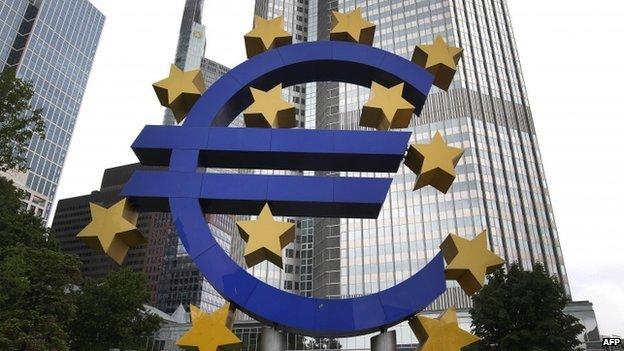Investors go mad (again)
- Published
- comments

The ECB is still cutting the cost of money
As I mentioned a few weeks ago, not everyone at the Bank of England shares Mark Carney's professed view that bubbling property is the gravest threat to financial stability and the sustainability of the recovery.
There was no ranking of dangers by Andy Haldane, the Bank's top economics boffin, in a speech delivered in restorative Scarborough last night, but he did share some serious anxieties about overheated financial markets.
And he warned that the Bank of England might have to exercise its more sweeping powers to damp down the speculation, lest it prove dangerous to banks and their ability to create essential credit.
So where are these risks manifesting themselves?
Well, in general, the prices of bonds and shares are very high and volatility is low. Which implies that investors have become a little myopic, a little unconscious of economic reality.
And as Haldane says, this is eerily reminiscent of conditions before the great Crash of 2007-08.
Here is one example he gave: the implied cost of borrowing for Spain and Italy for five years, which is close to the average maturity of their debt, is now lower than the cost of borrowing for the same period for the US and the UK.
This is shown by the yield on five-year government bonds, which is 1.33% for Spain, 1.44% for Italy, 1.65% for the US and 2.02% for the United Kingdom.
Now it was not long ago when Spain and Italy were close to catastrophe: there were legitimate fears of default on the poisonously intertwined debts of their respective banks and governments, bringing the Armageddon risk that such an earthquake could fracture the entire eurozone.
Are the debts of Spain and Italy now solid, glittering gold?
Errr, no.
Their economies, banks and public finances are a long long way from rude health.
Nor are the structural flaws in the eurozone anywhere near fixed: a course of steroids has been administered to banks by the European Central Bank; there is a little more pooling of countries' resources for bailouts; but the economic and political union widely seen as necessary to put monetary union on unbreakable foundations remains elusive.
In other words, the risk of default by Spain and Italy is significantly greater than for the UK and US.
So it seems little short of insane that investors are saying, in the price they pay to buy Spanish and Italian debts, that Spain and Italy are more creditworthy than the US and UK - both of which are enjoying the kind of economic recoveries that most of the eurozone would kill for.
To be clear, central banks themselves are partly responsible for Spanish and Italian bonds being so expensive (low yields or implied interest rates on bonds are the corollary of high prices).
The European Central Bank is still cutting the cost of money, whereas the US Federal Reserve and Bank of England are both on very gentle trajectories to increase interest rates.
But even if central banks are responsible for having made credit so cheap in recent years, with all the almost-free money they've created since the financial crisis of 2007-08, it takes two to tango.
And it is therefore reckless lending and investing by financial institutions - from banks to hedge funds - that has been pushing asset prices up to vertiginously high levels.
Which brings the risk that asset prices will tumble, at some inconvenient moment, wreaking serious harm to these financial institutions - and their ability to finance the economic activity crucial to our prosperity.
That is why Haldane says it may soon be time for the Bank of England to unleash what he calls "the rumble of thunder", or one of the weapons of the godlike central bank, to rebuke lenders and investors, and alter their behaviour.
This could take a number of forms. It could come as a public admonition to banks not to stock up on pricey bonds.
Or it could be the pioneering use by the Bank's young Financial Policy Committee of its so-called macroprudential powers to force banks to hold more capital to absorb potential losses on particular classes of overvalued assets.
Or the FPC could instruct banks to hold more loss absorbing capital across the board of their activities, by activating the so-called counter-cyclical buffer.
Or, if all else fails to dampen the potentially lethal exuberance, the Monetary Policy Committee could raise interest rates.
Which is, as Haldane says, the last line of defence.
But what matters is that interest rates are now seen as a defence against madness in financial markets, in a way that they weren't in the boom boom years of Greenspan and King.